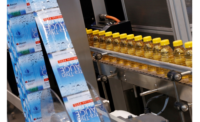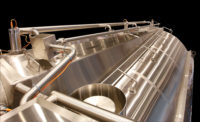Sustainability Advantages of High Pressure Food Processing
How HPP cuts waste, lowers emissions and helps build a healthier, safer planet.




The growth of high pressure processing (HPP) is driven by consumer demand for fresh taste without chemicals or preservatives. But that’s not the only reason why food processors and retailers choose HPP. It also delivers sustainability and cost saving advantages over other processing methods, such as thermal. Sustainability means meeting today’s needs without compromising the ability of future generations to meet theirs.
Reduce Energy Consumption
Compared to thermal pasteurization by autoclave of a fish-and-vegetable ready-to-eat meal with 60-day shelf life and in a comparative limited life cycle assessment, HPP had a global warming potential more than 20 percent lower, even when HPP processing included a precooking cycle.
Continuing advances in HPP equipment cycle time and productivity are further reducing energy requirements.
The potential for HPP to create longer shelf life for refrigerated or chilled foods also opens the door for some popular food items to be moved from frozen to chilled processing and distribution — and to reduce energy consumption.
Use Fewer Ingredients, Gain a Clean Label
HPP allows food processors to reduce or eliminate ingredients added solely for preservative effects, including chemicals that inhibit bacterial growth. Reduced ingredient usage means eliminating the environmental impacts associated with sourcing those ingredients.
A simpler ingredient list also helps food processors achieve “clean label,” which appeals to an increasing segment of the population who seeks healthy, natural choices in convenient foods and beverages.
While precise benefits are unquantified at this point, some common preservatives are linked to chronic health problems. Improving health reduces the environmental burden associated with treating serious illnesses and diseases.
Increase Nutritional Value of Food
HPP has been repeatedly shown to result in little or no change to essential nutrients, vitamins and sensitive health-related bioactive compounds. This yields foods with increased shelf life and better nutritional value. With HPP, less food is required to satisfy nutritional needs, and fewer supplements are required to replace vitamins and nutrients lost during thermal processing. These are results that increase the PP/EI ratio (product performance, environmental impacts) and represent advances in sustainability.
Improve Food Taste and Texture
Proper choice of HPP processing conditions can result in improvements in the taste and texture of food products compared to traditional processing methods. Upgrading lower-grade raw materials creates higher-value products that satisfy consumer quality desires and avoids more environmentally intensive food production approaches.
Inactivate Deadly Foodborne Viruses, Produce Safer Food
According to the U.S. National Institutes of Health (NIH), about 48 million Americans experience a foodborne illness each year, with the majority caused by harmful bacteria and viruses. HPP inactivates common foodborne pathogens such as E. coli, Salmonella and Listeria. Studies show the complete inactivation of Listeria monocytogenes in packaged, sliced cooked ham could eliminate negative health impacts to susceptible populations compared to L. monocytogenes in traditionally processed ham.
In the late 1990s, following the E. coli 0154:H7 outbreak in apple juice, Avure Technologies worked closely with the U.S. FDA to validate and gain approval of HPP as a processing method to achieve the FDA’s 5-Log pathogen rule.
|
Three Ways HPP Prevents Food Losses and Waste — 1 —
Extend Shelf Life, Curb Food WasteWith HPP’s improved shelf-life capabilities, manufacturers reach wider markets and reduce waste volume and the associated costs of waste: disposal cost, energy cost, increased resource cost of food production and increased greenhouse gas emissions. Coupled with the reduction of spoilage is the improvement of quality afforded with the longer shelf life. HPP products do not exhibit significant product deterioration as microbiological shelf life nears. This allows manufacturers to reduce the costs associated with distressed products and, more importantly, deliver a higher quality product to consumers. — 2 —
Avoid Harmful, Costly Production LossesThe least sustainable outcome is to lose all the material and energy inputs associated with producing and delivering a product because the product is unusable, while all the emissions, releases or other environmental impacts still occur. At that point, the performance-to-impact ratio becomes zero because no performance is realized but all the inputs have been spent and all the impacts incurred. — 3 —
Healthy Foods, Healthy PopulationLow-quality foods provide lower nutritional value to consumers, which can negatively impact health, well-being and productive capability of those consuming such foods. The performance-to-impact ratio becomes lower as nutritional value is lost. HPP helps products retain their natural vitamins and healthy nutrients after prolonged refrigeration. For example, a University of Leuven - Belgium study found that Valencia orange juice (made with HPP) retains 90 percent of its vitamin C after 20 weeks of storage — compared to thermal processing, which loses more than half of its vitamin C over the same time span. HPP further extends shelf life, especially for products with rapidly declining food quality. This benefits consumers, producers and retailers. For example, a grocery chain keeps shelves stocked with healthy and safe products from manufacturers. And longer expiration dates give consumers confidence to consume food they might otherwise purchase and discard. |
AVURE Technologies is a global leader in high pressure processing. With more than 60 years of experience in HPP, AVURE specializes in HPP systems for food and beverage processing. AVURE helps producers implement HPP from recipe development and process validations to installation, regulatory affairs, packaging and post-installation support. Vist avure-hpp-foods.com.
Looking for a reprint of this article?
From high-res PDFs to custom plaques, order your copy today!








